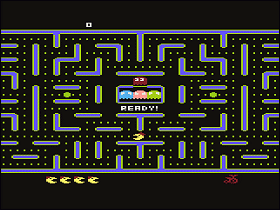 The Game: As the commander of a sleek Solvalou fighter, you’re deep into enemy territory, shooting their disc-shaped fighters out of the sky, bombing ground installations and artillery nests, bombing tanks, and trying to destroy the mothership. As you progress further behind enemy lines, heavier aircraft and more versatile and deadly ground-based defenses become the norm. Also look out for tumbling airborne mirrors – they’re impervious to your fire, but you’re toast if you fly right into them. (Atari, 1983)
The Game: As the commander of a sleek Solvalou fighter, you’re deep into enemy territory, shooting their disc-shaped fighters out of the sky, bombing ground installations and artillery nests, bombing tanks, and trying to destroy the mothership. As you progress further behind enemy lines, heavier aircraft and more versatile and deadly ground-based defenses become the norm. Also look out for tumbling airborne mirrors – they’re impervious to your fire, but you’re toast if you fly right into them. (Atari, 1983)
Memories: Based on a Namco import distributed under Atari’s banner in the U.S., Xevious may be about as close as one could get to replicating the arcade game with the 5200’s hardware. Curiously, though the copyright on the main menu screen is a year later than that on the unfinished 5200 Tempest proto, Xevious is a more complete game, fleshed out to a fully playable state.



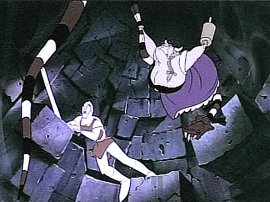 The Game: Princess Daphne has been kidnapped by the evil wizard Mordroc, and before he can embark on the dangerous quest to save her, Dirk must first fend off the angry attack of his Viking-like mother-in-law as he makes
The Game: Princess Daphne has been kidnapped by the evil wizard Mordroc, and before he can embark on the dangerous quest to save her, Dirk must first fend off the angry attack of his Viking-like mother-in-law as he makes 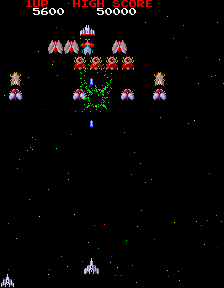 The Game: The Galaxian/Galaga saga continues! You control a solo space fighter against unending hordes of alien attackers who dive, weave, and evade your fire, while trying to nail your ship with their own shots. But one of
The Game: The Galaxian/Galaga saga continues! You control a solo space fighter against unending hordes of alien attackers who dive, weave, and evade your fire, while trying to nail your ship with their own shots. But one of  The Game: You’re piloting a lone tank trapped in an arena with numerous indestructible obstacles – and quite a few hostile tanks. The moment you’re sent into battle, those other tanks converge on you immediately, so survival usually
The Game: You’re piloting a lone tank trapped in an arena with numerous indestructible obstacles – and quite a few hostile tanks. The moment you’re sent into battle, those other tanks converge on you immediately, so survival usually 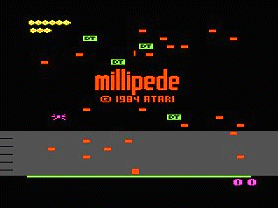
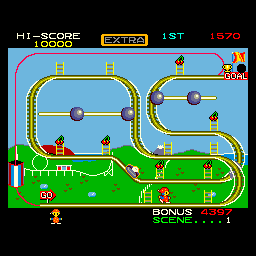 The Game: Mr. Do, having vanquished unicorns and other beasties, decides to take a little bit of vacation time at the nearest amusement park. But there’s one problem! (Isn’t there always?) The roller coasters are trying to kill him. Your job is to guide Mr. Do along the roller coaster tracks, avoiding deadly fast-moving roller coaster cars and climbing little ladders to reach cherries (is it my imagination, or does this guy eat more cherries than anybody since Pac-Man?). Watch your head at all times! (Universal, 1984)
The Game: Mr. Do, having vanquished unicorns and other beasties, decides to take a little bit of vacation time at the nearest amusement park. But there’s one problem! (Isn’t there always?) The roller coasters are trying to kill him. Your job is to guide Mr. Do along the roller coaster tracks, avoiding deadly fast-moving roller coaster cars and climbing little ladders to reach cherries (is it my imagination, or does this guy eat more cherries than anybody since Pac-Man?). Watch your head at all times! (Universal, 1984) The Game: As everyone’s favorite pixellated clown since Bozo, you guide Mr. Do around a multi-level platform, pursued by multicolored killer critters. You have a magic power ball you can shoot at them, but if you score a hit, you’ll have to scramble around and pick up fruit and other items on the platforms until you have the strength to hurl another power ball. If, in the other hand, your power ball doesn’t score a direct hit, it will ricochet back and forth across the screen until you retrieve it, or it hits a monster that has wandered into that part of the screen. (You can only have one power ball bouncing around at a time.) (Universal, 1984)
The Game: As everyone’s favorite pixellated clown since Bozo, you guide Mr. Do around a multi-level platform, pursued by multicolored killer critters. You have a magic power ball you can shoot at them, but if you score a hit, you’ll have to scramble around and pick up fruit and other items on the platforms until you have the strength to hurl another power ball. If, in the other hand, your power ball doesn’t score a direct hit, it will ricochet back and forth across the screen until you retrieve it, or it hits a monster that has wandered into that part of the screen. (You can only have one power ball bouncing around at a time.) (Universal, 1984) The Game: Pirates have boarded your ship, and it’s up to you to defend the whole boat. Evade the pirates in the twisty mazes of barrels and treasures in the cargo deck, or pick up one of those barrels and brain the nearest pirate with it. Be careful – some pirates hide inside the barrels, and it’s instant death to pick up an “occupied” barrel and not back off quickly. Some containers reveal a treasure when you pick them up, and you can go back and grab the treasures for bonus points. Clear the deck of pirates to advance to the next level and start again. (Capcom, 1984)
The Game: Pirates have boarded your ship, and it’s up to you to defend the whole boat. Evade the pirates in the twisty mazes of barrels and treasures in the cargo deck, or pick up one of those barrels and brain the nearest pirate with it. Be careful – some pirates hide inside the barrels, and it’s instant death to pick up an “occupied” barrel and not back off quickly. Some containers reveal a treasure when you pick them up, and you can go back and grab the treasures for bonus points. Clear the deck of pirates to advance to the next level and start again. (Capcom, 1984) The Game: You’re an adventurer with a bullwhip and a hat, and you hate snakes and love treasure – sound familiar? The bad news is that you’re surrounded by slippery snakes, scurrying scorpions and jumping spiders, all of whom can kill you instantly on contact. The only way you can eliminate these foes and claim the treasure is with a precisely-aimed crack of your whip…but if you’re surrounded, your treasure-hunting days are probably over. (Bally Sente, 1984)
The Game: You’re an adventurer with a bullwhip and a hat, and you hate snakes and love treasure – sound familiar? The bad news is that you’re surrounded by slippery snakes, scurrying scorpions and jumping spiders, all of whom can kill you instantly on contact. The only way you can eliminate these foes and claim the treasure is with a precisely-aimed crack of your whip…but if you’re surrounded, your treasure-hunting days are probably over. (Bally Sente, 1984) The Game: As the commander of a sleek Solvalou fighter, you’re deep into enemy territory, shooting their disc-shaped fighters out of the sky, bombing ground installations and artillery nests, bombing tanks, and trying to destroy the mothership. As you progress further behind enemy lines, heavier aircraft and more versatile and Buy this gamedeadly ground-based defenses become the norm. Also look out for tumbling airborne mirrors – they’re impervious to your fire, but you’re toast if you fly right into them. (Atari [under license from Namco], 1984)
The Game: As the commander of a sleek Solvalou fighter, you’re deep into enemy territory, shooting their disc-shaped fighters out of the sky, bombing ground installations and artillery nests, bombing tanks, and trying to destroy the mothership. As you progress further behind enemy lines, heavier aircraft and more versatile and Buy this gamedeadly ground-based defenses become the norm. Also look out for tumbling airborne mirrors – they’re impervious to your fire, but you’re toast if you fly right into them. (Atari [under license from Namco], 1984) The Game: Pong just got a lot more difficult. The table-tennis-inspired sport is now played at blow-your-hair-back speeds on a 3-D field, with vehicles called rotofoils serving as the paddles. Up to four players can compete, or you can humiliate yourself by trying to fight computer-controlled opponents. (Atari/Lucasfilm Games, 1984)
The Game: Pong just got a lot more difficult. The table-tennis-inspired sport is now played at blow-your-hair-back speeds on a 3-D field, with vehicles called rotofoils serving as the paddles. Up to four players can compete, or you can humiliate yourself by trying to fight computer-controlled opponents. (Atari/Lucasfilm Games, 1984)
 The Game: Alien ships are sliding toward you on a gridwork of energy; as the pilot of the Beamrider, your job is to destroy them before they get too close to home (i.e. the bottom of the screen). They can fire back, though, and while in some cases you can return fire and intercept their shots, it depends on what kind of weaponry they’re using. When you run out of Beamriders, the aliens take over. (Activision, 1984)
The Game: Alien ships are sliding toward you on a gridwork of energy; as the pilot of the Beamrider, your job is to destroy them before they get too close to home (i.e. the bottom of the screen). They can fire back, though, and while in some cases you can return fire and intercept their shots, it depends on what kind of weaponry they’re using. When you run out of Beamriders, the aliens take over. (Activision, 1984) 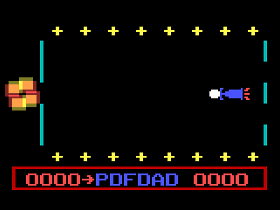 The Game: This is a tale of a futuristic society advanced almost beyond belief. A black hole has been trapped behind a force field, where its gravity won’t snag the chains of space outposts lining the top and bottom of the screen. That gravity will, however, attract stray asteroids, which naturally can do a number on the space stations. This is where you come in: as the captain of an interplanetary street-sweeper, it’s your job to grab the asteroids and deposit them in the maw of the black hole. It’s tricky, business: letting go of an asteroid too far away from the black hole will allow it to drift toward the space stations, but putting your own ship too close to the black hole will put you in harm’s way (and may still let the asteroid escape). The more asteroids you put in the black hole, the bigger and more powerful it becomes (did anyone really think through this method of disposing of the trash?), which will attract more asteroids and cause them to move faster. You can also shoot asteroids, but this will add no points to your score, and stray missiles could destroy space stations. If your ship plummets into the event horizon, or too many space stations are destroyed, there’s suddenly a vacancy for the most dangerous garbage disposal job in the universe. (GST Video, 1984)
The Game: This is a tale of a futuristic society advanced almost beyond belief. A black hole has been trapped behind a force field, where its gravity won’t snag the chains of space outposts lining the top and bottom of the screen. That gravity will, however, attract stray asteroids, which naturally can do a number on the space stations. This is where you come in: as the captain of an interplanetary street-sweeper, it’s your job to grab the asteroids and deposit them in the maw of the black hole. It’s tricky, business: letting go of an asteroid too far away from the black hole will allow it to drift toward the space stations, but putting your own ship too close to the black hole will put you in harm’s way (and may still let the asteroid escape). The more asteroids you put in the black hole, the bigger and more powerful it becomes (did anyone really think through this method of disposing of the trash?), which will attract more asteroids and cause them to move faster. You can also shoot asteroids, but this will add no points to your score, and stray missiles could destroy space stations. If your ship plummets into the event horizon, or too many space stations are destroyed, there’s suddenly a vacancy for the most dangerous garbage disposal job in the universe. (GST Video, 1984) The Game: The race is on, and no moves are off-limits – bump your competitors off the road (and into apparently highly volatile vegetation that causes them to explode), or jump over them and any other obstacles that get in your way, including areas of water that cover the road. If you survive the race, you live on to the next round – at least until you run out of cars. (Coleco, 1984)
The Game: The race is on, and no moves are off-limits – bump your competitors off the road (and into apparently highly volatile vegetation that causes them to explode), or jump over them and any other obstacles that get in your way, including areas of water that cover the road. If you survive the race, you live on to the next round – at least until you run out of cars. (Coleco, 1984) The Game: Zoom being the operative word here, your mission – as space hero Buck Rogers – is to fly in close quarters with all kinds of enemy ships, landers and structures, fending off their attacks, and generally staying alive as long as possible. Obligatory robot wisecracks and utterances of “beedy-beedy-beedy” not included. (Coleco [under license from Sega], 1984)
The Game: Zoom being the operative word here, your mission – as space hero Buck Rogers – is to fly in close quarters with all kinds of enemy ships, landers and structures, fending off their attacks, and generally staying alive as long as possible. Obligatory robot wisecracks and utterances of “beedy-beedy-beedy” not included. (Coleco [under license from Sega], 1984) The Game: Sometimes it’s not all about saving the whole freakin’ world. Sometimes it’s about just being a cabbie. Picking people up, zipping through traffic, and trying to get them to where they’re going without them – or yourself – killed in the process. Substitute traffic for alien ships and space debris, and you’ve got Cosmic
The Game: Sometimes it’s not all about saving the whole freakin’ world. Sometimes it’s about just being a cabbie. Picking people up, zipping through traffic, and trying to get them to where they’re going without them – or yourself – killed in the process. Substitute traffic for alien ships and space debris, and you’ve got Cosmic 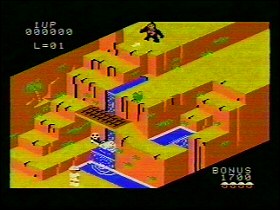 The Game: Bongo the Ape sets your toes on fire while you’re asleep during a jungle expedition. So naturally, you drop everything to take revenge on the goofy gorilla. But first you have to reach him. The first level is a hazardous assortment of ramps and levels and a waterfall to jump across. Be careful of pesky little monkeys who can weigh you down so you move slower (and jump lower), and watch out for snakes. Then you have to hop across various islands and dodge more snakes as you try to get across a river. (Coleco [under license from Sega], 1984)
The Game: Bongo the Ape sets your toes on fire while you’re asleep during a jungle expedition. So naturally, you drop everything to take revenge on the goofy gorilla. But first you have to reach him. The first level is a hazardous assortment of ramps and levels and a waterfall to jump across. Be careful of pesky little monkeys who can weigh you down so you move slower (and jump lower), and watch out for snakes. Then you have to hop across various islands and dodge more snakes as you try to get across a river. (Coleco [under license from Sega], 1984)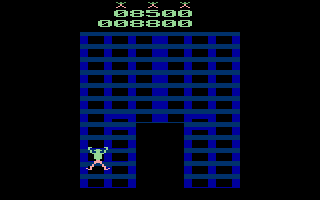 The Game: You control a daredevil stunt climber on his trip up the side of a building, using no ropes, no nets, and nothing but his hands and his feet. Obstacles such as a large stork with (apparently flaming) droppings can cause you to plunge to your death several stories below, and even minor things such as annoyed building tenants dropping potted plants at you from above can have the same disastrous effect. When you reach the top – if you reach the top, that is – a helicopter lifts you away to your next challenge. (Atari, 1984 – fan club exclusive)
The Game: You control a daredevil stunt climber on his trip up the side of a building, using no ropes, no nets, and nothing but his hands and his feet. Obstacles such as a large stork with (apparently flaming) droppings can cause you to plunge to your death several stories below, and even minor things such as annoyed building tenants dropping potted plants at you from above can have the same disastrous effect. When you reach the top – if you reach the top, that is – a helicopter lifts you away to your next challenge. (Atari, 1984 – fan club exclusive) The Game: Once again, you’re piloting a sleek spacecraft, patrolling the airspace over a populated planet whose inhabitants are being harvested by alien Landers to create berzerker Mutants. If you shoot down a Lander in mid-air and its abductee falls toward the ground, you must catch the helpless kidnap victim and lower him to the ground safely. Other menaces await you in the sky, along with Stargates, which instantaneously transport you to other locations around the planet. (Atari, 1984)
The Game: Once again, you’re piloting a sleek spacecraft, patrolling the airspace over a populated planet whose inhabitants are being harvested by alien Landers to create berzerker Mutants. If you shoot down a Lander in mid-air and its abductee falls toward the ground, you must catch the helpless kidnap victim and lower him to the ground safely. Other menaces await you in the sky, along with Stargates, which instantaneously transport you to other locations around the planet. (Atari, 1984)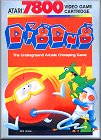 The Game: Who said landscaping was easy? You are Dig Dug, an intrepid gardener whose soil is infested with pesky Pookas and fire-breathing Fygars. You’re armed with your trusty pump, which you can use to inflate your enemies until, finally, they blow up. But both the Pookas and Fygars can crawl through the ground and can pop out into your tunnels, and if a Fygar sneaks up behind you, he can toast you if you’re not careful. (Atari, 1984)
The Game: Who said landscaping was easy? You are Dig Dug, an intrepid gardener whose soil is infested with pesky Pookas and fire-breathing Fygars. You’re armed with your trusty pump, which you can use to inflate your enemies until, finally, they blow up. But both the Pookas and Fygars can crawl through the ground and can pop out into your tunnels, and if a Fygar sneaks up behind you, he can toast you if you’re not careful. (Atari, 1984) The Game: You’re another treasure-hunting glory seeker who’s about to meet more than his match. If you can survive crossing the drawbridge into the castle – a task made incredibly difficult by the glowing fireballs of dragon breath being hurled toward you – you’ve got an even more hazardous obstacle ahead: the dragon himself is guarding a huge stash of treasure. Even if he can’t stop you from pocketing every shiny thing in the castle, chances are you won’t make it out alive. (Imagic, 1984)
The Game: You’re another treasure-hunting glory seeker who’s about to meet more than his match. If you can survive crossing the drawbridge into the castle – a task made incredibly difficult by the glowing fireballs of dragon breath being hurled toward you – you’ve got an even more hazardous obstacle ahead: the dragon himself is guarding a huge stash of treasure. Even if he can’t stop you from pocketing every shiny thing in the castle, chances are you won’t make it out alive. (Imagic, 1984) The Game: You’re a lone footsoldier fighting your way through a platoon of enemy troops, trying to take out as many of them as you can until you find your way to a handy empty tank. But once you man your own tank, enemy tanks surround you. If one of them hits your tank, you have mere seconds to bail out before your tank blows, and you have to dodge cannon fire until you can find another friendly tank to commandeer. After crossing hazardous stretches of desert and fighting off entire battallions of enemy tanks, you’re en route to the final confrontation, a showdown with the enemy’s armored headquarters… (Coleco, 1984)
The Game: You’re a lone footsoldier fighting your way through a platoon of enemy troops, trying to take out as many of them as you can until you find your way to a handy empty tank. But once you man your own tank, enemy tanks surround you. If one of them hits your tank, you have mere seconds to bail out before your tank blows, and you have to dodge cannon fire until you can find another friendly tank to commandeer. After crossing hazardous stretches of desert and fighting off entire battallions of enemy tanks, you’re en route to the final confrontation, a showdown with the enemy’s armored headquarters… (Coleco, 1984) The Game: You’re back in the maze, but this time, the stakes are increased, the danger is increased, and your strategic options are only slightly increased. Touching the walls, the robots, the robots’ laser blasts, or even your own ricocheted lasers are deadly. And of course, the inevitable appearance by Evil Otto is also deadly. However, you can temporarily repel the smiley little bugger by blasting him until his grin turns into the frown – but he will reappear mere seconds later, moving much faster every time he must retreat and reappear – so you’re not doing yourself any favors. If you enter a generator room, you can halt all the robots in their tracks by penetrating the walls surrounding the generator and blasting it. “Beaded” walls can be eaten away, bit by bit, by laser fire from anyone who shoots it, while solid walls will ricochet lasers around until they hit something – which could mean a death trap for you. (Coleco, 1984)
The Game: You’re back in the maze, but this time, the stakes are increased, the danger is increased, and your strategic options are only slightly increased. Touching the walls, the robots, the robots’ laser blasts, or even your own ricocheted lasers are deadly. And of course, the inevitable appearance by Evil Otto is also deadly. However, you can temporarily repel the smiley little bugger by blasting him until his grin turns into the frown – but he will reappear mere seconds later, moving much faster every time he must retreat and reappear – so you’re not doing yourself any favors. If you enter a generator room, you can halt all the robots in their tracks by penetrating the walls surrounding the generator and blasting it. “Beaded” walls can be eaten away, bit by bit, by laser fire from anyone who shoots it, while solid walls will ricochet lasers around until they hit something – which could mean a death trap for you. (Coleco, 1984)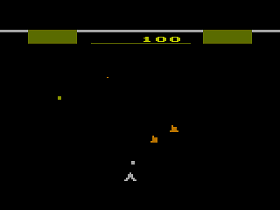 The Game: The aliens are taking their complaints to the home office! As the pilot of an agile space fighter, you have to blast your way through the alien forces from Pluto all the way back to Earth. Occasionally you can boost your ship’s firepower, but that’s the only help you’re going to get. The rest is up to your speed, your strategy, and your ability to nail those suckers in mid-dive. (Parker Brothers, 1984)
The Game: The aliens are taking their complaints to the home office! As the pilot of an agile space fighter, you have to blast your way through the alien forces from Pluto all the way back to Earth. Occasionally you can boost your ship’s firepower, but that’s the only help you’re going to get. The rest is up to your speed, your strategy, and your ability to nail those suckers in mid-dive. (Parker Brothers, 1984) The Game: You control the destiny of a pixellated rock band. A menu presents you with options to write songs, play concerts, go on tour, or even sign witha record company if you’ve racked up the money and the popularity (and the band still has the energy and drive to work a crowd). You can ask your manager to try to work out some special deals for you, but even success has its dark side – and what’s worse, now the dark side of stardom is randomly generated! (Xonox / K-Tel, 1984)
The Game: You control the destiny of a pixellated rock band. A menu presents you with options to write songs, play concerts, go on tour, or even sign witha record company if you’ve racked up the money and the popularity (and the band still has the energy and drive to work a crowd). You can ask your manager to try to work out some special deals for you, but even success has its dark side – and what’s worse, now the dark side of stardom is randomly generated! (Xonox / K-Tel, 1984)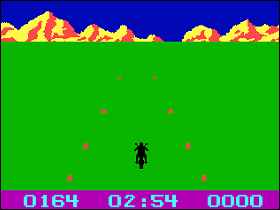 The Game: It’s a cross-country motorcycle race, and you’re at the handlebars. Avoid other bikes, stay within the traffic markers, and be alert to constantly changing lighting conditions and weather (this race is 24 hours a day, and the days seem awfully short). (Philips, 1984)
The Game: It’s a cross-country motorcycle race, and you’re at the handlebars. Avoid other bikes, stay within the traffic markers, and be alert to constantly changing lighting conditions and weather (this race is 24 hours a day, and the days seem awfully short). (Philips, 1984)